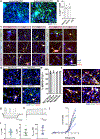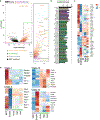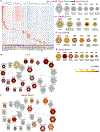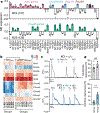Diverse reprogramming codes for neuronal identity
- PMID: 29743677
- PMCID: PMC6483730
- DOI: 10.1038/s41586-018-0103-5
Diverse reprogramming codes for neuronal identity
Abstract
The transcriptional programs that establish neuronal identity evolved to produce the rich diversity of neuronal cell types that arise sequentially during development. Remarkably, transient expression of certain transcription factors can also endow non-neural cells with neuronal properties. The relationship between reprogramming factors and the transcriptional networks that produce neuronal identity and diversity remains largely unknown. Here, from a screen of 598 pairs of transcription factors, we identify 76 pairs of transcription factors that induce mouse fibroblasts to differentiate into cells with neuronal features. By comparing the transcriptomes of these induced neuronal cells (iN cells) with those of endogenous neurons, we define a 'core' cell-autonomous neuronal signature. The iN cells also exhibit diversity; each transcription factor pair produces iN cells with unique transcriptional patterns that can predict their pharmacological responses. By linking distinct transcription factor input 'codes' to defined transcriptional outputs, this study delineates cell-autonomous features of neuronal identity and diversity and expands the reprogramming toolbox to facilitate engineering of induced neurons with desired patterns of gene expression and related functional properties.
Figures















Comment in
-
More than one way to induce a neuron.Nature. 2018 May;557(7705):316-317. doi: 10.1038/d41586-018-04978-5. Nature. 2018. PMID: 29752451 No abstract available.
-
Recipes for Making Neurons using Combinatorial Forward Genetics.Cell Stem Cell. 2018 Jul 5;23(1):13-14. doi: 10.1016/j.stem.2018.06.012. Cell Stem Cell. 2018. PMID: 29979987
References
-
- Davis RL., Weintraub H. & Lassar AB. Expression of a single transfected cDNA converts fibroblasts to myoblasts. Cell 51, 987–1000 (1987). - PubMed
-
- Takahashi K. & Yamanaka S. Induction of pluripotent stem cells from mouse embryonic and adult fibroblast cultures by defined factors. Cell 126, 663–676 (2006). - PubMed
-
- Caiazzo M. et al. Direct generation of functional dopaminergic neurons from mouse and human fibroblasts. Nature 476, 224–227 (2011). - PubMed
Publication types
MeSH terms
Substances
Grants and funding
- R01 DA043268/DA/NIDA NIH HHS/United States
- R01 DA041750/DA/NIDA NIH HHS/United States
- UL1 TR001114/TR/NCATS NIH HHS/United States
- R01 DA046204/DA/NIDA NIH HHS/United States
- U54 GM114833/GM/NIGMS NIH HHS/United States
- R01 DA036241/DA/NIDA NIH HHS/United States
- R01 MH102698/MH/NIMH NIH HHS/United States
- DA031566/DA/NIDA NIH HHS/United States
- MH102698/MH/NIMH NIH HHS/United States
- R01 GM083924/GM/NIGMS NIH HHS/United States
- R01 AA025012/AA/NIAAA NIH HHS/United States
- R01 DC012592/DC/NIDCD NIH HHS/United States
- R21 DA040458/DA/NIDA NIH HHS/United States
- DP1 AG055944/AG/NIA NIH HHS/United States
- R01 DA031566/DA/NIDA NIH HHS/United States
LinkOut - more resources
Full Text Sources
Other Literature Sources
Molecular Biology Databases

